The Bourbon Street Shots crew did a deep review of lineup data in an effort to tackle the Pelicans’s inconsistency issues. We can’t control effort and motivation, but we damn sure can look at our spreadsheets and figure out who clicks with who. And that’s exactly what we did. Below is a tag team effort on the part of myself (Kumar) and our newest writer, Patrick Fenerty (@PhilJFry5). So let’s get started shall we?
How Much Has Rondo Really Been A Factor?
Kumar: The current Pelicans starting lineup is struggling. Rondo, Holiday, Moore, Davis, and Cousins have a net rating of -0.2 since the Pelicans started kicking off games with this crew. Yes, the offense has been elite, and it’s easy to point to Rondo being the turning point, but the Pelicans’s starting lineup is hemorrhaging 108.2 points per 100 possessions on the defensive end too. With negative defenders in Rondo and Cousins bookending the defense and a 6’3” E’twuan Moore fighting for his life at small forward, the Pelicans have the defensive constitution of a house of cards. Sneeze, and it collapses.
Logging 292 minutes, this lineup has now become the most played lineup in the Gentry era. But is it worth holding onto? Is Rondo really helping the offense? Let’s take a look at the following piece of data.
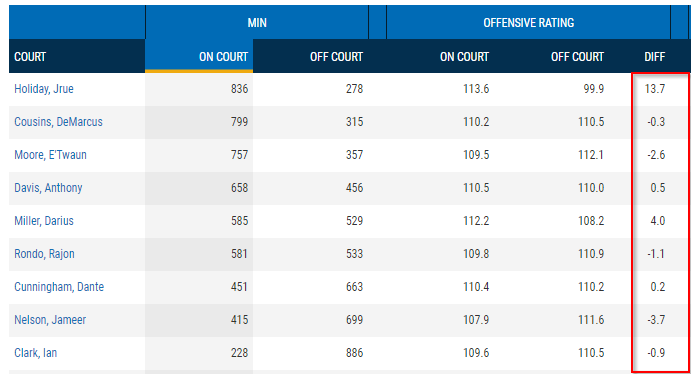
This is a chart showing how each player has impacted the Pelicans’s offensive rating since Rondo shed his minutes restriction on 11/18, sorted by minutes played. There are a few things going on here.
- The Pelicans have been slightly better on offense when Rondo is off the floor. While the difference between 109.8 and 110.9 is minimal at best, this is mildly surprising. Raw net ratings can be noisy and the eyetest strongly suggests that the Pelicans look great on offense with Rondo at the helm. And that’s true! An offensive rating of 109.8 is good for 6th in the league currently and is an extremely good offense. But the data seems to be saying the Pelicans also have an elite offense without Rondo. This leads us to our next point.
- The vast majority of the players are not impacting the offense strongly one way or the other. The offense is relatively stable no matter who is on the floor, and relatively elite throughout. We see a smattering of negatives and positives but almost all of them are small numbers. Outside of Jrue, the offensive scale ranges from slightly elite to more elite. This is extremely surprising and should be a testament to the system the staff has put together. You know it’s a good system when single players aren’t derailing the productivity of the team. Which brings us to our final point.
- The offense dies without Jrue Holiday. He is the only player the Pelicans can’t seem to survive without. Davis has Cousins to back him up, Rondo has Nelson, and Moore alternates with Miller – all comparable pieces in the rotation given their roles. There is no substitute for Jrue, and probably a large reason why he leads the team in minutes played
The Defense Needs Fixing Too
So the offense is remarkably stable and good with or without Rondo, this is good. However the defense is bleeding points. Who are the major culprits?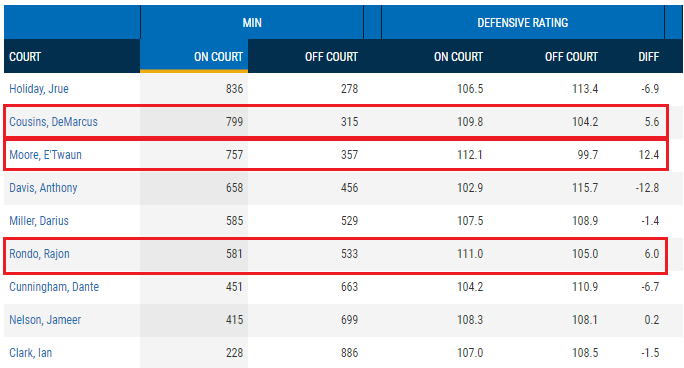
Like the chart above, this is a chart showing each player has impacted the Pelicans’s defensive rating since Rondo was shifted into the starting lineup full-time sorted by minutes played. I took the liberty to highlight the three biggest culprits of a remarkably poor defense. Rondo and Cousins were perhaps expected, with the Pelicans’s defense being around 6 points per 100 possessions better when either of them are OFF the floor. The Pelicans being 12.4 points better when Moore sits is not only surprising, but absolutely killing the team. Moore is in the midst of his best offensive season ever and has been a consistent offensive weapon for the Pelicans, but the poor guy is in survival mode on the defensive end. Something has to change, the Pelicans cannot continue to have their most used lineup include 3 vulnerabilities on the defensive end.
The Pelicans Are Not Starting Halves Well
The beginning of the first and third quarters are typically when both teams’ starters are on the floor. Since Rondo was inserted in the starting lineup, I want you to look below at the net ratings of each Pelicans player in the first and third quarters.
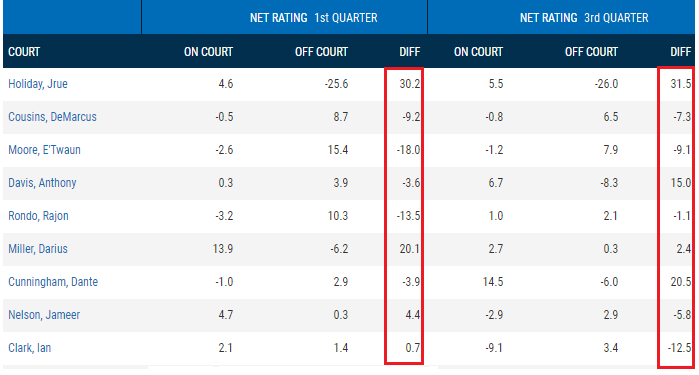
At first glance, the starters outside Jrue are negative, and the bench is positive. In the third quarter it is more of the same save for Davis also going into the strong positives. I’ve written about how Davis centric lineups crush it, but there has to be a better way to optimize the rotations. To understand this, we need to understand the substitution patterns. Here is a visualization of the current rotation since Rondo was inserted into the starting lineup courtesy of Patrick. I’m going to lob it up to him help explain what we are looking at and what is possibly going on with the rotations. Take it away, Patrick.

Rotations
Patrick: To try to understand the Pelicans rotations, I’m only going to look at games after Rondo came back and started playing full minutes (starting November 17th). The rotations graphic also excludes games where Anthony Davis missed time with injury.
The first 3 quarters of the Pelicans rotations look pretty consistent. To start the game, the five starters will play together for the first 6 or 7 minutes of the game, and then Alvin Gentry will make his first subs. As Kumar pointed out, the start to the halves when all 5 of those starters are in hasn’t been great. Since Rondo started playing a full allotment of minutes, the starting 5 has logged around 15 minutes per game together, and outscored the opponent by 1 point per game. So while they aren’t an outright negative, they aren’t establishing much of a lead either.
With the first substitutions Gentry brings in Jameer Nelson, Dante Cunningham, and Darius Miller. That trio has played 10.9 minutes per game together, outscoring opponents by 2.9 points per game in that time. On the surface, these units look to be doing better than the starters. The likely reasons for this are 1) opponents are also taking their starters out of the game at this point and 2) those 3 are also still sharing the court with some pair of Cousins, Davis, and Holiday.

Nelson, Cunningham, and Miller are all low usage players, coming in at USG%’s of 15.7, 9.9, and 14.1 respectively. Combined they shoulder less of the offense than Cousins does by himself in these lineups. So while, the Pelicans do well once the bench comes in, it is more a function of their big 3 being aggressive and taking advantage of opponents’ second units than actual contributions from the bench players.
An Inconsistent 4th Quarter
As I mentioned earlier, the Pelicans rotations through the first 36 minutes of the game look consistent, but we can see Gentry has been more experimental in the 4th quarter and so far returns are not great.
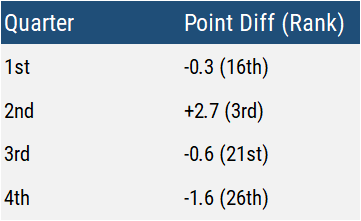
One concern we’ve heard specifically from Gentry has been Rondo’s effect on the offense late in the game. With Rondo’s lack of shooting ability, opponents can go under picks and clog the lane. Gentry’s alternative was to insert Jameer Nelson at the point guard spot, but so far that has not had the intended effect on the offense. Interestingly enough though, both Rondo and Nelson have a negative on/off differential.
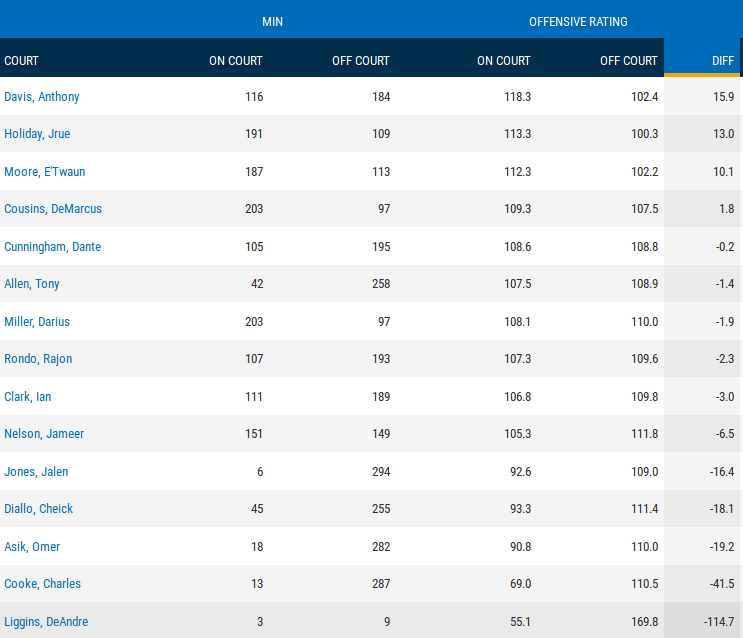
But consistent with the larger trend for the Pelicans, defense is where their problems really show. Their offense overall in the 4th still rates in the top 10, but their defensive rating at 112.5 is good for 27th in the NBA.
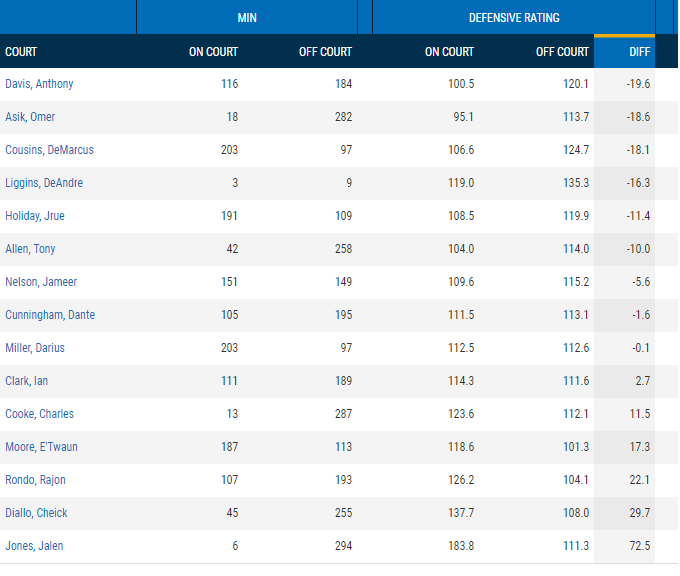 Davis is, unsurprisingly, the Pelican with the largest statistical effect on the defense in the fourth quart. The Pelicans have struggled even more than usual when he missed time. The Pelicans five worst fourth quarter defensive ratings in this stretch were against Denver, Houston, Golden State, Utah, and Memphis; all games Davis missed the fourth quarter, all losses. The first three we can attribute to the opponents, but even without AD the Pels should be able to manage a defensive rating under 130 in crunch time against Utah and Memphis.
Davis is, unsurprisingly, the Pelican with the largest statistical effect on the defense in the fourth quart. The Pelicans have struggled even more than usual when he missed time. The Pelicans five worst fourth quarter defensive ratings in this stretch were against Denver, Houston, Golden State, Utah, and Memphis; all games Davis missed the fourth quarter, all losses. The first three we can attribute to the opponents, but even without AD the Pels should be able to manage a defensive rating under 130 in crunch time against Utah and Memphis.
Conclusion
Kumar: There is a lot going here and we just threw a lot of charts and numbers at you. The bottom line is this, the Pelicans current substitution patterns are less than ideal. This begins with the starting lineup, which has been mediocre at best, and ends in the 4th quarter where there seems to be no solidified rotation. I think it’s high time the coaching staff ditched the current group of starters in favor of a lineup that will contribute more on the defensive end. Nailing down the right group of starters and solidifying the 4th quarter rotation should ideally help the Pelicans get out of this .500 funk. There are many promising combinations in this group of players, it’s now on the staff to find the right ones.
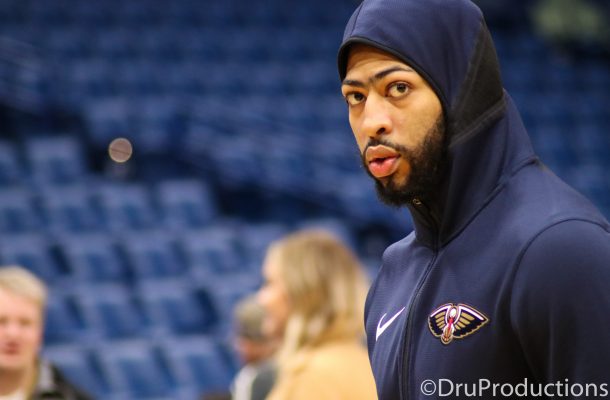
One response to “A Deep Dive into Rotations”
It seems to me out best lineup would have to include the big 3 and the 2 who have played the best outside of them this year – Moore and Miller. This would allow Moore to guard 2’s while Miller plays SF. While I understand the desire to play Jrue off the ball, this could be a 2nd and 4th quarter closing lineup. Ideally, we get Hill back next month and a trade of our first round pick will yield 1-2 rotation players, this eliminating minutes for Asik SNF limiting Cunningham and Nelson’s PT.